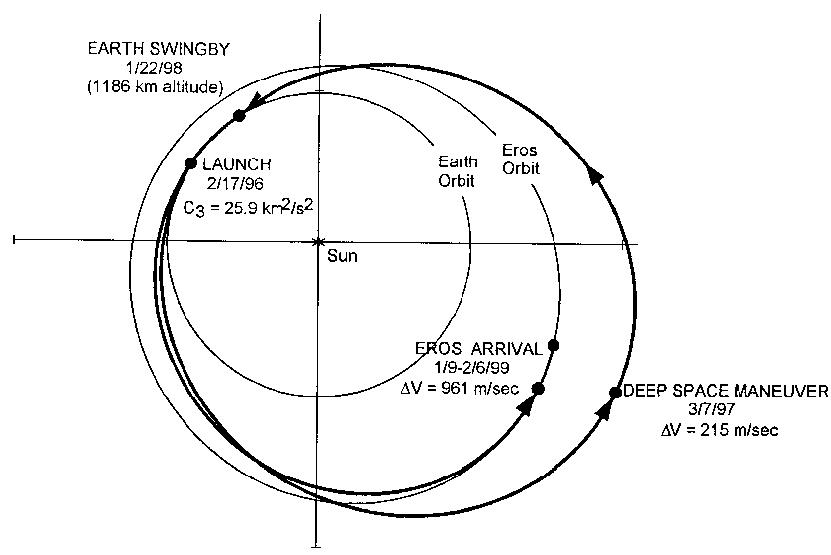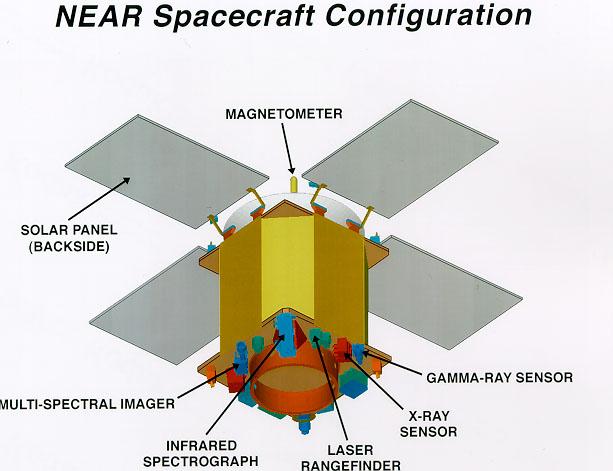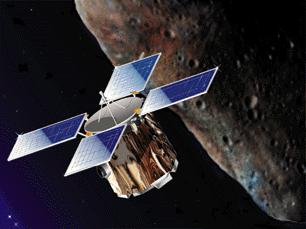Originally, a second asteroid flyby was not considered. A search for nearby targets along NEAR's flight path revealed a number of candidates. Most of these were small. Eventually, scientists found that the large main-belt asteroid 253 Mathilde was close enough to NEAR's trajectory that a flyby would consume a small amount of maneuvering fuel. Mathilde is a C-class asteroid with a 17-day period of rotation and a diameter of 61 kilometers. This makes Mathilde the largest asteroid ever observed by a spacecraft. If formally approved, the Mathilde flyby will take place on June 27,1997. Following the asteroid flyby, NEAR will conduct a deep space maneuver which will increase the spacecraft's inbound velocity for its one and only Earth swing-by in January 1998. NEAR will reach Eros in January 1999.
NEAR will make its initial close pass with Eros on February 6, 1999. The spacecraft will pass Eros on its sunlit side at the distance of 500 kilometers. This first pass will enable NEAR to collect important baseline information. Such data include the mass of Eros, its rotation period, and its shape. The identification of any moons or companions will be critical, as the mission team will need all of this information to place NEAR into a safe and proper orbit around Eros.
 Once in orbit NEAR will use a high-resolution camera to provide global image maps of Eros at a resolution as high as 3 meters. The spacecraft's near-infared spectrometer will map the mineral composition of the surface. The gamma ray/X-ray spectrometer will measure the abundance of key elements. These would in turn be compared to meteorite samples collected here on Earth. A magnetometer will measure the solar wind environment around Eros. It will also find out whether or not the asteroid has a magnetic field. A laser altimeter and radio science package will help answer questions about the internal structure of Eros, specifically whether or not Eros is a solid body, has a core, etc.
Once in orbit NEAR will use a high-resolution camera to provide global image maps of Eros at a resolution as high as 3 meters. The spacecraft's near-infared spectrometer will map the mineral composition of the surface. The gamma ray/X-ray spectrometer will measure the abundance of key elements. These would in turn be compared to meteorite samples collected here on Earth. A magnetometer will measure the solar wind environment around Eros. It will also find out whether or not the asteroid has a magnetic field. A laser altimeter and radio science package will help answer questions about the internal structure of Eros, specifically whether or not Eros is a solid body, has a core, etc. The spacecraft design of NEAR was driven by the need to build a low-cost yet reliable spacecraft. Total development costs were $115 million, far less than the $150 million funding cap for the Discovery program. The spacecraft took 27 months to develop. NEAR has a design lifetime of four years. The spacecraft itself has a box shaped bus. It uses four solar arrays capable of providing 350 watts of power. The spacecraft has a 1.5 meter high gain antenna. In addition, two low gain and one medium gain antenna are also included. Data transmission rates will be as high as 18 kilobytes per second when using the Deep Space Network dishes. NEAR also has a dual mode propulsion system with a large fuel capacity that gives the spacecraft a great deal of mobility. Two tape recorders are provided to record and store data for later playback. The NEAR mission is operated out of the Applied Physics Lab at Johns Hopkins University. Navigation support will be provided by Jet Propulsion Laboratory.
NEAR is expected to provide a wealth of information on asteroids, including their role in the evolution of the solar system as well as their role in the development of life on Earth. NEAR is not the only asteroid mission on the drawing boards. Japan is looking at a Near-Earth asteroid flyby and sample return mission. It is also possible that the Cassini mission may encounter 1 or more asteroids on its way to Saturn. The NEAR mission is just the first of a glut of exciting space missions that will further our knowledge of the solar system that is our backyard.
-Written by Michael Koller

 Near-Earth asteroids have long been considered excellent candidates for planetary missions for a number of different reasons. Asteroids represent a "Rosetta Stone" for scientists as they are widely believed to be leftovers from the formation of the solar system. Many believe that a close-up study of these lumps of rock and metal could yield important clues about the processes that formed the planets. Interest in asteroids spans a number of different fields. These include astronomy, geology, or even biology. Many geologists have found evidence that a massive asteroid impact killed off the dinosaurs and dozens of other plant and animal species 65 million years ago. As a class of objects, near-Earth asteroids have orbits that lie relatively close to Earth. As a result, these objects are easy to reach.
Near-Earth asteroids have long been considered excellent candidates for planetary missions for a number of different reasons. Asteroids represent a "Rosetta Stone" for scientists as they are widely believed to be leftovers from the formation of the solar system. Many believe that a close-up study of these lumps of rock and metal could yield important clues about the processes that formed the planets. Interest in asteroids spans a number of different fields. These include astronomy, geology, or even biology. Many geologists have found evidence that a massive asteroid impact killed off the dinosaurs and dozens of other plant and animal species 65 million years ago. As a class of objects, near-Earth asteroids have orbits that lie relatively close to Earth. As a result, these objects are easy to reach. 
